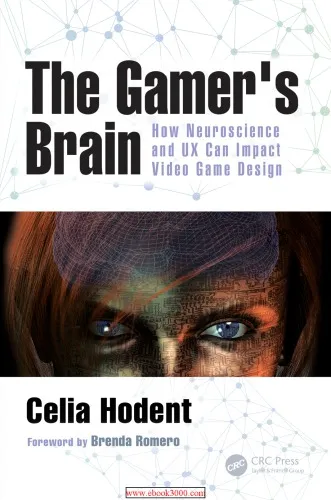The gamer's brain: how neuroscience and UX can impact video game design
4.3
Reviews from our users

You Can Ask your questions from this book's AI after Login
Each download or ask from book AI costs 2 points. To earn more free points, please visit the Points Guide Page and complete some valuable actions.Introduction to "The Gamer's Brain: How Neuroscience and UX Can Impact Video Game Design"
Welcome to a comprehensive exploration of the intricate relationship between neuroscience, user experience (UX), and video game design. Written by Celia Hodent, an expert in cognitive science and UX, "The Gamer's Brain" bridges the gap between the science behind how people think and feel, and the art of creating engaging, enjoyable video games. This book provides practical insights and science-backed guidance for game developers, designers, and anyone curious about how human psychology influences the gaming experience.
In the world of video game design, understanding how the brain functions and processes information is critical to creating immersive and accessible experiences. "The Gamer’s Brain" explains how cognitive science principles, when applied thoughtfully, can enhance video game design to not only capture attention but keep players engaged on a deeper level. Design challenges such as user onboarding, maintaining flow, combating frustration, and encouraging engagement are tackled through a holistic neuroscience and UX lens.
Whether you're a seasoned game developer, a UX professional, or a neuroscience enthusiast intrigued by the gaming industry, this book delivers actionable frameworks, relatable examples, and thought-provoking concepts to redefine your perspective on what makes a game truly succeed. Let’s dive into the main themes and ideas that make "The Gamer's Brain" an essential read.
Detailed Summary of the Book
At its core, "The Gamer’s Brain" is structured around the universal principles of cognitive science and UX design, applied to video games.
The book begins by introducing the basics of cognitive psychology, such as perception, memory, attention, motivation, and learning. It explains how these cognitive systems impact the way players interact with games and make key decisions. With everyday examples and game-specific scenarios, readers gain a foundational understanding of how cognitive limitations, such as the constraints of working memory, shape the player experience.
As the book progresses, Hodent delves deeper into how UX design principles can solve common issues in game development. Topics include maintaining the "flow" state in gameplay, creating intuitive controls, designing informative tutorials, handling cognitive load, and mitigating frustration points. Throughout, Hodent emphasizes the iterative process of design: learning through feedback, testing prototypes, and refining ideas collaboratively to meet players’ needs.
One of the standout aspects of the book is its attention to accessibility and inclusivity. Cognitive science tools are presented as a way to design games for a wider audience, including players with different levels of experience, abilities, or even disabilities. The scientific insights offered here empower developers to deliver meaningful & fun gaming experiences for everyone.
Key Takeaways
- The brain processes information in limited ways; designing inclusive and accessible games requires developers to account for these constraints.
- Effective onboarding and tutorials help players understand games without overwhelming them early on.
- "Flow" is essential for immersive gaming experiences; finding the balance between challenge and skill level is crucial.
- Playtesting and user feedback are indispensable for refining game design and solving potential UX issues.
- Inclusivity doesn’t just mean accommodating disabilities—it also means considering diverse audiences and their perspectives.
Famous Quotes from the Book
"Games are systems designed to engage players, and understanding the human brain is the key to creating systems that resonate."
"Without considering cognitive load, even the most visually stunning and well-animated games will fail to capture their audience."
"UX is not about making a product look good—it’s about making a product feel good to use."
Why This Book Matters
The relevance of "The Gamer's Brain" lies in its ability to blend neuroscience with actionable design strategies to transform how games are developed and experienced.
In an industry driven by innovation, developers face constant pressure to create games that not only entertain but also provide memorable experiences. This book offers a scientific methodology for addressing questions like: How can we make games too "sticky" to quit? How can onboarding feel seamless, not frustrating? And how do we foster deep emotional or cognitive connections between players and the games they play?
Celia Hodent’s approach equips creators with tools to tackle these challenges, not just from an artistic viewpoint, but from a user-centered perspective. It’s insightful for UX professionals and game developers hoping to deliver experiences that truly cater to their player base. Moreover, cognitive science and UX insights have value beyond gaming, applying equally in fields like education, management, and interactive design.
Ultimately, "The Gamer's Brain" is a call to action for creators to embrace empathy, experimentation, and evidence-based design, ensuring that gaming remains one of the most dynamic and enriching forms of entertainment in the modern era.
Free Direct Download
Get Free Access to Download this and other Thousands of Books (Join Now)
For read this book you need PDF Reader Software like Foxit Reader
Accessing books through legal platforms and public libraries not only supports the rights of authors and publishers but also contributes to the sustainability of reading culture. Before downloading, please take a moment to consider these options.
Find this book on other platforms:
WorldCat helps you find books in libraries worldwide.
See ratings, reviews, and discussions on Goodreads.
Find and buy rare or used books on AbeBooks.


